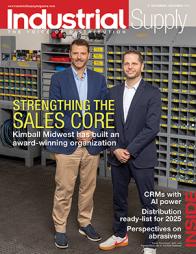What’s Your Strategy for Speed?
Don’t waste time in your distribution center or warehouse. . . time is what your DC/Warehouse is actually made of!
 Unlike manufacturing environments, in wholesale distribution, wasted time does not litter the factory floor like wasted material. Time waste differs from material waste in that there can be no salvage. You just don’t see it.
Unlike manufacturing environments, in wholesale distribution, wasted time does not litter the factory floor like wasted material. Time waste differs from material waste in that there can be no salvage. You just don’t see it.
Once time passes, it can never be retrieved. That moment’s productivity potential is lost forever.
On a daily basis, there are a lot of good examples of this concept of time waste occurring in every DC or warehouse. Generally, little of it has to do with a warehouse worker's attitude or motivation to get the work done. Yes, sometimes it can be a training issue. More likely, it’s about not really knowing your warehouse or distribution center. What do I mean by that?
The 10-Plus Wastes
Years ago, lean practitioners identified the original seven wastes that are typically evidenced in a warehouse or DC. Shortly thereafter, the list grew to eight wastes. Over the years, I have identified a few more. In fact, I suggest that there are now 10-plus wastes, with each one, to one degree or another, prevalent in most DCs or warehouses. Many of them continue go unseen or undetected (please email me at: hcoleman@mcaassociates.com for a complete list and a description of each waste).
Particularly for DC and warehouse operations of 25,000 square feet or more, they continue to suffer from significant inefficiencies – wasting time and resources – usually having to do with poor storage methods, ill-conceived storage capacities, problems with the proper location and accessibility of products, and how to go about constructing the best “routes” for directed put-away, replenishment of bins, and picking activities.
So here, “Strategy for Speed” means speeding up fulfillment without losing accuracy and increasing cost.
Why Not Incorporate Lean Thinking solutions into your “Strategy for Speed”?
Some basic facts:
- It’s an indisputable fact that 40% to 70% of a picker's time is spent walking. Similar percentages exist for other major warehouse operational functions, i.e.; put-away. Much of that 40% to 70% is taken up just getting to the location and product, even before you pick, or put-away. So, value is realized at work areas, not in transit or commuting between them.
- Picker productivity is more a function of “hit density” than pick-rate, particularly once the picker gets to where he/she is going to. In other words there is significant benefit in increasing the picking opportunities by shortening the distance between picks and increasing the number of picks per stop. Therefore, the introduction of better product location methodology, storage media, utilization of space, and how the “pick-face" is offered to the picker is one of the quickest ways to achieve higher pick-rates.
- There still seems to be a basic skepticism that exists when it comes to considering batch or zone picking options, and whether it will actually yield higher productivity. Frankly, this needs to give way to better logic. The old reasoning and excuses – that it increases processing time or reduces accountability (leading to more errors) and, as a result, continues to foster the picking of discrete orders – no longer has any wind behind their sails.
- Conveyor system transport of product, even basic gravity-fed conveyor, is an often under-utilized resource option and could be a major asset to your strategy for speed.
- Flow-racking is another under-utilized resource option, particularly in offering an extremely flexible pick face for fast-moving products, simplifying bin replenishment, and optimizing the ergonomics of product storage and retrieval.
- Many DCs and warehouses still incorporate old warehouse design and layout concepts. Smart storage, retrieval and product flow design can go a long way toward reducing wasted time. It also enhances the ROI of your warehouse management system investment. WMS is just a tool. It can’t function alone – without a strategy of smart design.
- Critical DC/Warehouse performance measurements are often lacking. There are several critical metrics which can provide a baseline measure for continuous improvement.
So What Will Your “Strategy For Speed” Be?
First, a question: Why not begin by investing in more time and resources to study and identify opportunities that could provide productivity gains in your DC/warehouse?
I remain somewhat disappointed that I don’t often enough see a strategy for speed. I see attempts at improvements being made all the time, but often in a piecemeal fashion. For instance; “Let’s give the folks some new picking carts…that will speed them up!” "Let’s buy another forklift, that’ll help!” While not bad ideas, they are just tools, not a strategy.
Frankly, it’s not like these types of efficiency discussions are new to wholesale distributors. Within a DC or warehouse, the goal has always been to reduce processing time for all the major warehouse functionalities, hasn’t it? Yet, the basic lean objective: less travel + fewer touches = less cost, for many, remains unrealized – as well as the ability to provide for the quality of the touches.
For a more detailed review of this topic, and some specific recommendations for change you can use and make right now, click here.
Here’s how MCA Associates can help.
Howard W. Coleman is principal of MCA Associates, a management consulting firm that, since 1986, has worked with wholesale distribution and manufacturing companies that are seeking and committed to operational excellence. Our staff of senior consultants provides operational excellence – thought leadership – and implements continuous improvement solutions focused on business process re-engineering, inventory and supply chain management, sales development and revenue generation, information systems and technology, organizational assessment and development, and family-business succession planning. MCA Associates may be contacted at 203-732-0603, or by email at hcoleman@mcaassociates.com. Visit our website at www.mcaassociates.com.











